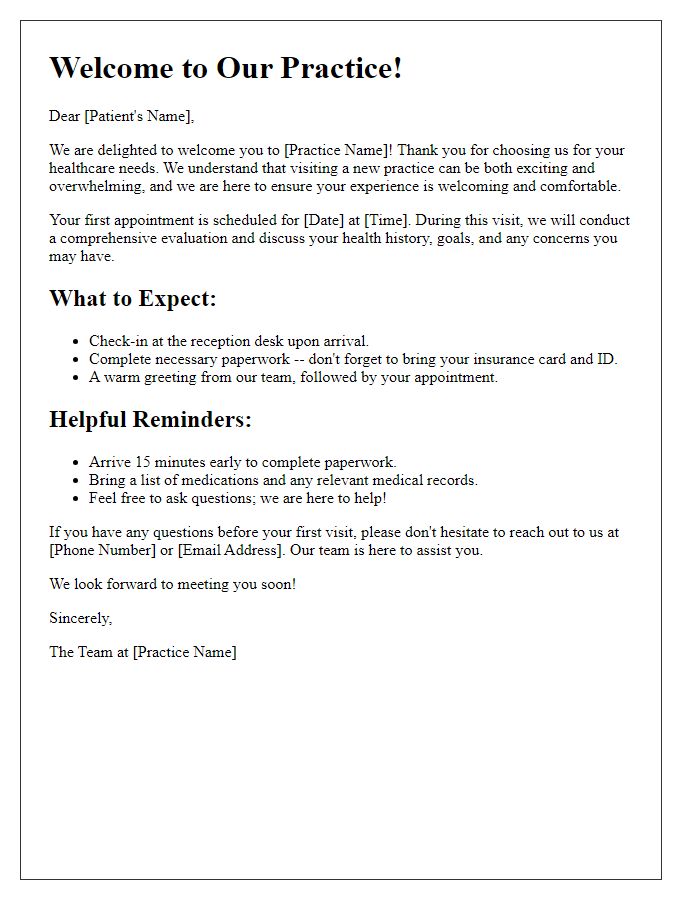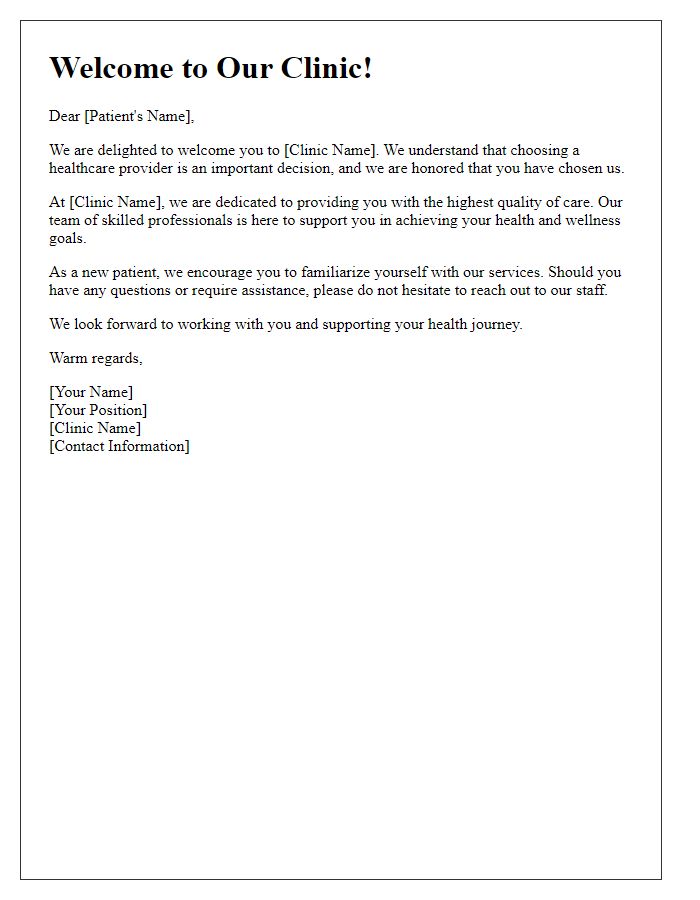Welcome to our practice! We are thrilled to have you as a new patient and look forward to providing you with the best possible care. Our dedicated team is here to ensure your experience is both comfortable and informative, making it easy for you to navigate your health journey. Curious about what to expect at your first visit? Let's dive into the details!

Personalized greeting
A new patient welcome letter establishes a positive connection with individuals visiting a healthcare facility for the first time. This communication often includes important details about the office's location, services offered, and procedures to follow during the initial visit. Personalized greetings can enhance the relationship by using the patient's name, creating a warm and inviting atmosphere. Key elements include office hours, contact information, and guidelines for paperwork completion, ensuring clarity and ease for patients navigating their first appointment. This approach ultimately helps patients feel valued and informed, fostering trust in their new healthcare providers.
Introduction and practice overview
Welcome letters for new patients serve as a vital introduction to healthcare practices, establishing a comforting rapport from the start. This initial communication often includes essential information about the practice, such as its founding date (for example, established in 2010), location (like Main Street Health Center in Springfield), and the primary healthcare services provided (family medicine, pediatrics, or preventive care). Additionally, a brief overview of the staff qualifications and experience can enhance patient trust, illustrating a commitment to quality care. Details such as office hours (9 AM to 5 PM, Monday through Friday), appointment scheduling procedures, and insurance acceptance policies (participating with major providers such as Blue Cross or Aetna) should be included to facilitate seamless access to services. Moreover, incorporating a personal welcome message from the lead physician or practice manager emphasizes the patient-centered approach, reassuring new patients about their decision to join.
Patient-friendly language
The welcome letter template has been designed to ensure new patients feel comfortable and informed as they begin their healthcare journey. The practice name, located in a community rich with health resources, emphasizes compassionate care. Inside the envelope, patients find details about their first appointment, including date, time, and the importance of bringing personal identification and insurance information. The letter encourages patients to jot down questions they might have, promoting proactive engagement. Additionally, newcomers receive information on the practice's values, including patient-centered approaches and streamlined communication channels. The letter ends with welcoming words, assuring patients that the entire team is ready to support their health goals.
Contact information and office hours
Welcoming new patients to a healthcare practice is crucial for establishing a positive relationship and ensuring they feel valued. A well-crafted welcome letter should provide essential contact information for easy communication, including the main office phone number (often listed as (555) 123-4567) and email address (like info@healthcareprovider.com). Additionally, office hours play a significant role in patient accessibility--these hours may typically span Monday through Friday, from 9 AM to 5 PM, with specific hours designated for evening appointments on Thursdays until 7 PM. Including details about after-hours services or an emergency contact number can further enhance patient reassurance and accessibility. It's important to personalize the letter, perhaps with the name of the welcoming physician or practice manager, to foster a friendly and inviting atmosphere from the outset.
Privacy and confidentiality assurance
New patients can expect a high level of privacy and confidentiality in their healthcare experience. Healthcare providers are committed to protecting personal health information (PHI) in accordance with the Health Insurance Portability and Accountability Act (HIPAA) regulations, which enforce strict guidelines on information security and patient consent. All patient records are securely stored in a digital electronic health record (EHR) system, accessible only to authorized personnel. Regular staff training sessions reinforce the importance of confidentiality in patient interactions, ensuring that sensitive information remains private. Patients are encouraged to ask questions about their rights and the measures in place to safeguard their data during their visit.













Comments